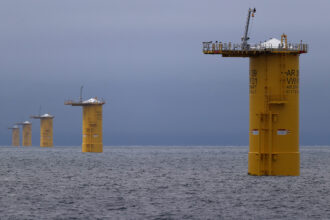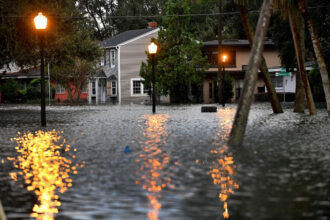An ambitious new climate change initiative at MIT’s Sloan School of Management seeks to harness the collective knowledge of the university to help tackle the climate crisis by connecting current and future climate research to policy.
The MIT Climate Policy Center will be part of a new and larger campus-wide initiative called the Climate Project at MIT, which aims to mobilize different parts of the university to “develop, deliver, and scale up practical climate solutions as quickly as possible,” according to Richard K. Lester, MIT’s vice provost.
“MIT is never better than when we come together to solve big problems,” MIT President Sally Kornbluth said in a video announcing the launch of the Climate Project.
The video recalled key roles MIT played in developing radar for the U.S. military in World War II, putting the first astronauts on the moon, plugging the hole in Earth’s protective ozone layer and mapping the human genome. Tackling climate change is “MIT’s most ambitious project yet,” Kornbluth said.
Robert Stavins, director of the Environmental Economics Program at Harvard University, who is not involved in the MIT initiative, said leading research universities can play important roles in connecting the scientific and policy communities. “For major societal problems, such as global climate change, it is important not just to carry out path-breaking, relevant research, but to communicate the results of that research to the policy community, including key stakeholders in government, NGOs and private industry,” Stavins said. “The new MIT center will—I hope—provide a two-way street of communication between academic research and policy action.”
The larger initiative will receive $75 million in initial funding from the university, including $25 million from the Sloan School, making it the largest direct investment by MIT in funding climate work. Lester said to the MIT News Office, “We anticipate developing new partnerships, including philanthropic partnerships, to increase that scope dramatically.”
Still, some fear the university could turn to fossil fuel companies, as it has in the past, for additional funding, which could compromise the initiative’s objectives.
Nathan Shwatal, a co-lead of MIT Divest, a student-led climate advocacy organization calling for the university to end its investments in fossil fuel companies, expressed cautious optimism about the new initiative. “There’s great hope for the research,” Shwatal said. “But there’s also a dark path that it can go down when it comes to fossil fuel funding.”
Shwatal said this has been the case with MIT’s Energy Initiative, a research center at MIT separate from the Climate Project whose mission, according to the Initiative’s website, is to “develop low- and no-carbon solutions that will efficiently meet global energy needs while minimizing environmental impacts and mitigating climate change.”
The Energy Initiative has raised more than $1 billion for energy research since it was established in 2006, approximately 45 percent of which has come from oil and gas companies, a spokesperson for the MIT Energy Initiative said.
The top two tiers of current funders listed on the Initiative’s website are composed entirely of oil and gas companies, including ExxonMobil, Shell and Chevron.
Benefits for the top tier, or “founding members,” include membership on the Energy Initiative’s external advisory board, governing board and its executive committee. Founding members are also offered their own office on MIT’s campus and can participate in the Initiative’s research portfolio review meetings.
“Sustaining members,” the second highest tier, receive some of the above listed benefits as well as additional benefits, including participation in workshops, monthly webinars and symposia.
Douglas Almond, co-director of the Center for Environmental Economics and Policy at Columbia University, described the Energy Initiative’s funding in exchange for access as “baldly direct” and “awful.”
There’s “what looked to us like a menu of influence, where depending on the donation amount, you would receive external advisory board membership,” said Almond.
Kornbluth said the benefits provided to Energy Initiative funders did not compromise research. “All our research is independent and openly reported, and funders don’t have any say in that,” she said. “That’s long been spelled out in any funding agreements and will continue to be.”

Christopher Knittel, a professor of energy economics at the Sloan School who will serve as the new Climate Policy Center’s faculty director, said the new center would not seek funds from any corporation, and would use the $25 million in start-up money from the Sloan School as an endowment.
“The Climate Policy Center is not going to fundraise through corporations,” Knittel said. “It’ll be through the endowment that has already been provided as well as philanthropic organizations.”
The larger Climate Project at MIT hasn’t publicly declined to accept investments from fossil fuel companies.
A 2022 study Almond and colleagues published in the Journal Nature Climate Change found that university research centers funded by fossil fuel companies are more supportive of fossil fuels than similar university energy centers that do not receive fossil fuel funding. The study analyzed the language used in more than 1,700 reports from 26 university energy centers, including three that received significant fossil fuel funding.
Those that received money from fossil fuel companies, including MIT’s Energy Initiative, characterized natural gas more favorably in written reports than similar university energy centers that did not receive fossil fuel funding, the study found. Further, centers that received fossil fuel funding described renewable energy less favorably than centers that did not receive money from the industry, according to the study.
A key example cited by Almond and colleagues was an influential MIT Energy Initiative report from 2011 on the future of natural gas. The report called for the federal government to support “unconventional” or hydraulically fractured natural gas, which had recently begun to boom in the U.S. The report also called on the government to support a global natural gas market, in the form of liquid natural gas.
“The U.S. should pursue policies that encourage the development of a [global liquid natural gas] market, integrate energy issues fully into the conduct of U.S. foreign policy, and promote sharing of know-how for strategic global expansion of unconventional gas production,” the MIT report concluded.
Soon after the report was published, the Energy and Natural Resources Committee of the U.S. Senate invited the report’s lead author, Ernest Moniz, then head of the Energy Initiative, to brief the committee on the report’s findings.
President Obama included many of the report’s findings when outlining the nation’s new energy policy in 2012, and, in 2013, appointed Moniz to serve as secretary of energy.
“There’s just a very direct line from these energy centers to policymaking and policy decisions,” Almond said.
The U.S., once an importer of LNG, is now the world’s leading exporter.
Natural gas is a relatively clean-burning fuel, releasing roughly half the amount of carbon dioxide as coal. However, methane, the primary component of natural gas, is a potent greenhouse gas, more than 80 times worse than carbon dioxide over a 20-year period. If even a small amount of methane leaks into the atmosphere before the gas is burned, the climate impact of burning natural gas can be worse than burning coal.
“It’s been getting this bye, or this pass, that I don’t think it deserves,” Almond said of natural gas. The Biden administration announced in January that it would pause the approval of new LNG export terminals while it evaluates the climate impact of additional gas exports.
The MIT Energy Initiative website states that its funders “are critical in the energy innovation chain, linking MIT’s world-class research teams with innovators in industry and government to address pressing energy challenges and move solutions into the marketplace.”
The Energy Initiative’s research portfolio “focuses exclusively on clean energy,” the spokesperson for the Energy Initiative said. “MITEI [the MIT Energy Initiative] presently does no research related to oil, gas and coal exploration or extraction.”
The companies providing funding to the Energy Initiative, she said, “come to MIT to learn about and support the development” of renewable energy technologies.
“Some, including the fossil energy companies, must radically change course, and in some cases get out of their present lines of business,” she said. “They invest heavily, and for the long term, in critical MIT research programs in areas such as fusion, solar, wind, battery storage, carbon capture and carbon-free fuel. We meet with the executives of these companies regularly as members of our governance committees to inform them about our research and education programs.”
Jake Lowe, executive director of the Campus Climate Network, an international student-led coalition that seeks to end university energy research funding from the fossil fuel industry, said accepting industry money is problematic.
“If you were the president of a leading public health school and you wanted to be a leader on lung health research, you would not accept funding from the tobacco industry and frame that as bringing in multiple perspectives and collaborating with industry,” Lowe said. “I think the same is true of fossil fuel money and climate research.”
“With respect to funding, I’ve honestly heard a range of views,” Kornbluth said in an email. “I welcome that conversation.”
Moniz, who is currently a physics professor at MIT and special advisor to President Kornbluth, said industry engagement can accelerate the clean energy transition. “We certainly need to pick up the pace and the ambition of innovation in technology, business models and policy,” Moniz said.
This story is funded by readers like you.
Our nonprofit newsroom provides award-winning climate coverage free of charge and advertising. We rely on donations from readers like you to keep going. Please donate now to support our work.
Donate NowMIT’s Climate Project is still under development, and fundraising for the initiative beyond the initial university funding will be led by a yet-to-be named vice president for climate at MIT. A plan for the project released by the university notes that financial support will include “sponsored research funds.”
“We’ll need to raise significant external funding to reach our ambitions,” said Kimberly Allen, a spokesperson for MIT.
“Where’s that money going to be coming from?” Shwatal of MIT Divest asked. “Are we going to be facing the same problems that the Energy Initiative has been proven to face or is this really going to be a truly revolutionary research plan?”
MIT Divest plans to meet with university officials this week and next with the hope of getting answers to some of these questions, Shwatal said.
“Overall, it seems like it’s a good direction to go in,” Shwatal said. “But there are also things that we are kind of wary of.”













